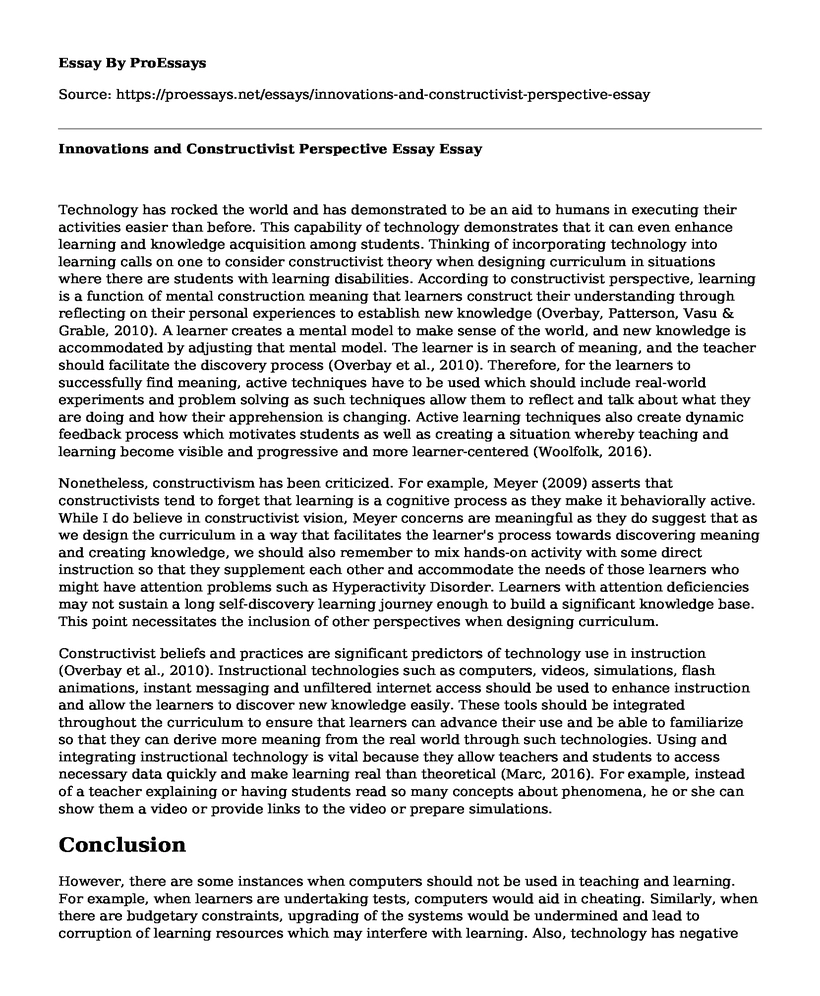Technology has rocked the world and has demonstrated to be an aid to humans in executing their activities easier than before. This capability of technology demonstrates that it can even enhance learning and knowledge acquisition among students. Thinking of incorporating technology into learning calls on one to consider constructivist theory when designing curriculum in situations where there are students with learning disabilities. According to constructivist perspective, learning is a function of mental construction meaning that learners construct their understanding through reflecting on their personal experiences to establish new knowledge (Overbay, Patterson, Vasu & Grable, 2010). A learner creates a mental model to make sense of the world, and new knowledge is accommodated by adjusting that mental model. The learner is in search of meaning, and the teacher should facilitate the discovery process (Overbay et al., 2010). Therefore, for the learners to successfully find meaning, active techniques have to be used which should include real-world experiments and problem solving as such techniques allow them to reflect and talk about what they are doing and how their apprehension is changing. Active learning techniques also create dynamic feedback process which motivates students as well as creating a situation whereby teaching and learning become visible and progressive and more learner-centered (Woolfolk, 2016).
Nonetheless, constructivism has been criticized. For example, Meyer (2009) asserts that constructivists tend to forget that learning is a cognitive process as they make it behaviorally active. While I do believe in constructivist vision, Meyer concerns are meaningful as they do suggest that as we design the curriculum in a way that facilitates the learner's process towards discovering meaning and creating knowledge, we should also remember to mix hands-on activity with some direct instruction so that they supplement each other and accommodate the needs of those learners who might have attention problems such as Hyperactivity Disorder. Learners with attention deficiencies may not sustain a long self-discovery learning journey enough to build a significant knowledge base. This point necessitates the inclusion of other perspectives when designing curriculum.
Constructivist beliefs and practices are significant predictors of technology use in instruction (Overbay et al., 2010). Instructional technologies such as computers, videos, simulations, flash animations, instant messaging and unfiltered internet access should be used to enhance instruction and allow the learners to discover new knowledge easily. These tools should be integrated throughout the curriculum to ensure that learners can advance their use and be able to familiarize so that they can derive more meaning from the real world through such technologies. Using and integrating instructional technology is vital because they allow teachers and students to access necessary data quickly and make learning real than theoretical (Marc, 2016). For example, instead of a teacher explaining or having students read so many concepts about phenomena, he or she can show them a video or provide links to the video or prepare simulations.
Conclusion
However, there are some instances when computers should not be used in teaching and learning. For example, when learners are undertaking tests, computers would aid in cheating. Similarly, when there are budgetary constraints, upgrading of the systems would be undermined and lead to corruption of learning resources which may interfere with learning. Also, technology has negative impacts on the student growth including altered wiring of the brain (distraction and decreased memory and also affects emotional growth as it may lead to reduced ability to empathize or poor moods among the children (Chu, 2014). Thus, use of technology should be moderated to ensure that students do not overly rely on them to an extent it causes a distraction to psychological and emotional growth.
References
Chu, H. C. (2014). Potential Negative Effects of Mobile Learning on Students' Learning Achievement and Cognitive Load--A Format Assessment Perspective. Journal of Educational Technology & Society, 17(1).
Marc, P. (2016). Shaping Tech for the Classroom: ITSE Technology Standards. Retrieved from http://www.iste.org/standards/standards/for-students-2016
Meyer, Derek, L. (2009).The poverty of constructivism. Educational Philosophy and Theory, 41(3).
Overbay, A., Patterson, A. S., Vasu, E. S., & Grable, L. L. (2010). Constructivism and technology use: findings from the IMPACTing Leadership project. Educational Media International, 47(2), 103-120. doi:10.1080/09523987.2010.492675.
Woolfolk, (2016). Chapter 10: "Constructivism and Designing Learning Environments." Pearson.
Cite this page
Innovations and Constructivist Perspective Essay. (2022, Jul 07). Retrieved from https://proessays.net/essays/innovations-and-constructivist-perspective-essay
If you are the original author of this essay and no longer wish to have it published on the ProEssays website, please click below to request its removal:
- Data Securing Essay Example
- Detection of Ransomware Which Is a Malware That Continues to Cause Significant Data Damage and Financial Losses
- Challenges of Security Department Speech Paper Example
- Article Analysis Essay on Artificial Intelligence, Robots and Work
- The Essential Role of IT Security in Contemporary Society - Essay Sample
- The Mobile Revolution: Catering to Consumers' Needs &Preferences - Essay Sample
- Free Research Paper Sample on Uncovering Truths Through Qualitative Research: Confirmability, Dependability & More







